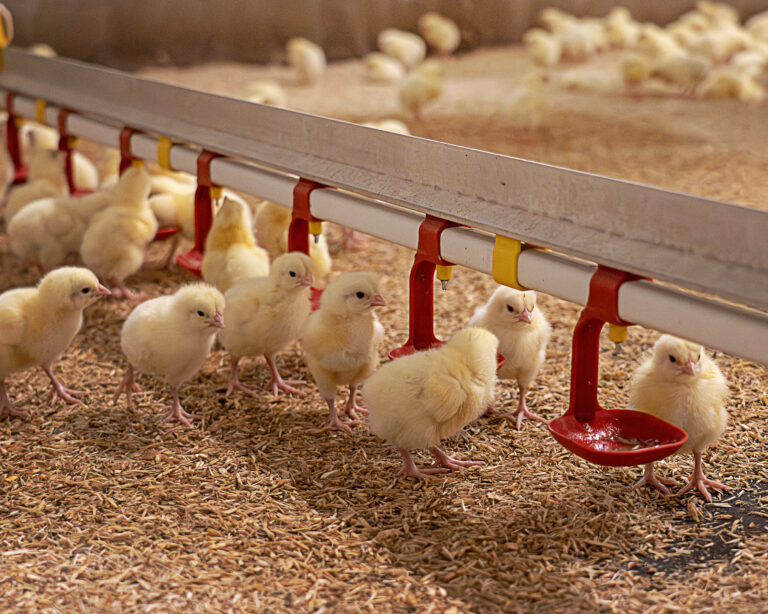George Adsetts, who grows broilers in Chesterfield, explains why hygiene is crucial for maximising performance
George Adsetts rears 500,000 broilers per cycle with seven cycles per year, totalling 3.5 million birds on all-in all-out systems across three units in the East Midlands. One of these units is his family farm near Chesterfield, where 140,000 birds per cycle are reared in four identical sheds built in 2000. All birds are grown for Gafoor Poultry Products in Preston.

Chicks move into woodchip bedded sheds at 40g and are reared until 30 days at which point they are thinned out by a third, selling birds weighing 1.6kg. The remainder stay until 38 days at 2.8kg. Feed conversion averages 1.5 with 3-4% mortality.
“Hitting growth and feed conversion targets is key to the business and to our relationship with our processor,” says Adsetts. “We need to control all we can and pay close attention to biosecurity to reduce the risk of pathogenic infections. All sheds are vermin proofed, all feed comes from UFAS approved mills and we implement rigorous vehicle and human disinfection protocols.
“Central to our biosecurity is thorough and effective cleaning and disinfection between flocks as this is our one chance to prepare the building ahead of the next cycle of chicks arriving and ensure they go into the best environment.”
As soon as birds have left the farm, the sheds are cleaned by the farm team to remove all muck and bedding. They are blown down to remove any debris across the fittings, before being pre-soaked with a misting system before the washing team arrives. Adsetts explains this additional stage helps improve the effectiveness of the clean as the detergent lands on a damp surface.
The contract cleaning company washes all surfaces using a 2% foam detergent solution which is then left for 30-60 minutes before being rinsed off from the top to bottom of the shed. The buildings are then left overnight to dry before application of a disinfectant.
Neogen Viroxide Super, a Defra approved disinfectant, is applied using an orchard spray at 1%. This is left to stand for several hours with sheds vented to improve drying. The floors are then disinfected a second time with Neogen Farm Fluid MAX which is effective against the three leading strains of Eimeria – a protozoa which can lead to coccidiosis. In addition to chlorocresol (CMK), the primary biocide, Neogen Farm Fluid MAX includes a solvent for increased solubility, and a surfactant to meet challenging farm conditions.
Once the sheds are thoroughly dry, Adsetts swabs the drinking lines, feeding lines, floors and walls. The swab results confirm how effective the protocol has been by giving a measure of bacterial activity.
There is real time pressure to complete the process if we are to hit the target for cycles and I want to leave buildings empty for seven days between cycles, even though Red Tractor stipulates just five days,” Adsetts adds. “The turnaround time on swabs means the results are not back until after we have restocked, but they provide valuable information we can use to review the effectiveness of hygiene protocols to make more informed decisions next time.”
However, if producers are looking for instant results, they could opt for measuring adenosine triphosphate (ATP) and have valuable information on the effectiveness of their clean before new chicks arrive.
Dan Clow from Neogen stresses the importance of regularly reviewing the cleaning protocols to ensure they are as effective as possible. He explains that pathogens are constantly evolving, meaning habitual disinfectants may be less effective, making it important to review the disinfectants used.
“When developing a programme, it is important to ensure chemicals are used in the right order to prevent them from working against each other. It is also important to ensure they are used at the correct dilution, with an appropriate contact time to allow them to work.”
Adsetts believes regularly reviewing the programme helps keep on top of pathogen risks, tackling any areas of concern. “We can manage the applications and the physical process, but we have to trust the chemistry.
“By paying attention to detail on cleaning and disinfection, we can ensure each new cycle gets off to the best possible start and reduce the risk of pathogens compromising how a cycle will grow and use feed efficiently,” he says.


